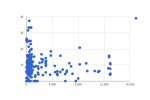I added the age of the star to the Worlds tab, which also has total and % of the various types of materials found. I then summed the % of VR found on each planet and put that in another column and used the 'correlate' function to see if there was a linear correlation between the star age and % of VR found. I noticed there were some odd entries (worlds where only VR had been found, so probably someone got lucky and didn't continue to survey) and I removed those (there were three of them). The resulting correlation was -0.0579 and change, which does slightly favor younger stars giving out a higher % of VR, but is really low and (IMO) not at all conclusive.
I'm not a statistician, so I could be making a mistake. I've left the columns on the World tab in case anyone else wants to take a look.
PS There are relatively few entries in the System tab because each system can have multiple worlds and each world can have multiple surveys and each survey can have multiple log entries.
Thank you Starry! A valiant effort. I should mention that the trend I noticed was the meteorites spawned first or quickly on the younger planets. So those data points with just "early rares" might not be inaccurate. Also, the spawn rate of
very rares is so low in general that using it as a statistical metric would be problematic at best. I think a better measure might be the total sum of "rares +very rares" vs "the total mats collected". All while noting the frequency of meteorites. Also, we don't know how long the CMDRs were searching. They could have roamed for 3 hours and waited until they found a meteorite before they mined the first node thus resulting in "paydirt." And metallicity is a metric is correlated to age, it has a high variance, so you need a LARGE sample size to show the trend accurately (assuming there really is one!). The test conditions also should be identical which means:
same time period
similar landing sites
similar star type
similar number and distribution of bodies
etc
Of course, I wouldn't expect anyone else to be meticulous for someone pot brained theory on the internet. And since I am the one hypothesizing that this *might* still be true, it is up to me to offer the proof, or put it to rest.

